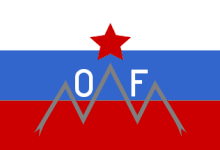Osvobodilna Fronta

The Osvobodilna Fronta ( OF ; German Liberation Front ) was the political resistance organization of Slovenia (then part of Yugoslavia ) against the occupation by the Axis powers during the Second World War .
history
The OF was probably founded on April 26, 1941 (the official date is April 27, 1941) in the apartment of the writer Josip Vidmar in Ljubljana and was called the Anti-imperialist Front until the German invasion of the Soviet Union on June 22, 1941 (Slovenian: Protiimperialistična fronta ; abbreviated: PIF ).
The founding members were the Communist Party of Slovenia , the Slovenian Christian Socialists , the Slovenian Sokol ( falcon ) and a group of cultural workers. The OF declared its goals to be liberation from fascism , the unification of all Slovenes - also meant the Slovenian ethnic groups in Austria ( Styrian Slovenes , Carinthian Slovenes ), Italy (which at that time included important areas with a Slovenian population, Istria , Trieste and Gorizia ) and Hungary - within Yugoslavia and the establishment of a fairer society than it had been in the Kingdom of Yugoslavia . They set up a partisan army which, together with partisans from other parts of Yugoslavia, and from 1942 also with Allied support, waged a war against the occupiers and their supporters on the ground. The OF also joined former fighters of the TIGR in the then Italian Julisch Venetien as well as partisans in Austrian Carinthia . In Carinthia, the OF associations under the leadership of local communists, which operated north of the Drau, particularly on the Saualpe , were the most important armed resistance organization against the German occupation forces with around 700 fighters in August 1944. The Reichsführer SS Heinrich Himmler therefore declared southern Carinthia a "gang fighting area".
In September 1941, the OF declared itself to be the Slovenian National Liberation Committee , the highest political body in the new Slovenia. The OF set up liberation committees in liberated areas, which organized, among other things, the school system, cultural system, health care and care for the partisans. On February 28, 1943, the founding members published the "Dolomites Declaration" (Dolomitska izjava) , with which the Communist Party was established as the leading force and as a result of which the other parties became meaningless.
At the founding of the Anti-Fascist Council of National Liberation of Yugoslavia (AVNOJ) on 26 November 1942 at the Bosnian Bihac no representatives of the OF could participate, but only during the second AVNOJ conference from 21 to 29 November 1943 in Jajce , and the so-called " AVNOJ resolutions " were taken.
After the capitulation of Italy on September 3, 1943, elections were held for an assembly of representatives of the people, who in turn elected a new 120-member supreme plenum and a 10-member executive committee of the OF. The latter also served as the Slovenian National Liberation Committee. In February 1944, the Slovenian National Liberation Council was convened as the legislature in Črnomelj . On May 5, 1945, this council in Ajdovščina named the new Slovenian government, which was relocated to Ljubljana on May 10, 1945.
After the end of the war
After the end of the war, the OF was transformed into the Socialist League of the Working People .
The day of the founding of the OF in the city of Ljubljana, April 27th, is still a public holiday in Slovenia and is celebrated as the “Day of the Uprising Against the Occupier” ( Dan upora proti okupatorju ). In Yugoslavia it was called “Day of the Liberation Front” ( Dan osvobodilne fronte ).
Establishment date
The official founding date of the OF was April 27, 1941. There are no minutes of the meeting so the date was given orally. After the end of the war, April 27 was set as an official holiday. Based on memories of those involved, it later became apparent that April 26th was the actual date of foundation with a greater probability.
Individual evidence
- ^ Documentation archive of the Austrian resistance, Mitteilungen 163: Victims of political persecution in Austria. ( Memento of December 10, 2011 in the Internet Archive ) (accessed December 27, 2015)
literature
- Enciklopedija Slovenije (Encyclopedia of Slovenia), Volume 4, p. 238, Volume 8, pp. 199-202, Volume 12, p. 49, Volume 14, p. 386, Mladinska knjiga publishing house , Ljubljana, 1990, 1994 , 1998, 2000.
- Tamara Griesser-Pečar : The torn people. Slovenia 1941-1946. Occupation, collaboration, civil war, revolution (= studies on politics and administration 86). Böhlau Verlag, Vienna et al. 2003, ISBN 3-205-77062-5 , chapter: "Liberation struggle and polarization"